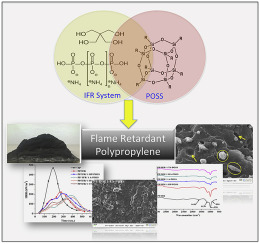Polymer Degradation and Stability ( IF 5.9 ) Pub Date : 2018-02-01 , DOI: 10.1016/j.polymdegradstab.2018.01.025 Gizem Turgut , Mehmet Dogan , Umit Tayfun , Guralp Ozkoc

|
In the current study, the effects of four different POSS nanoparticles on the flame retardant properties of intumescent PP were investigated through mass-loss calorimetry (MLC), limiting oxygen index (LOI) test and UL-94 ratings. In addition, the structure-property relationship was enlightened via thermal, morphological and mechanical tests. The four different POSS types, namely aminopropyl isobutyl-POSS (A-POSS), octaphenyl-POSS (OP-POSS), octaammonium-POSS (OA-POSS) and trissulfonic acid propyl-POSS (TS-POSS), were used. The ratio of ammonium polyphosphate (APP) to pentaerythritol (PER) was kept constant and the POSS content was varied as 0.5%, 1% and 3%. The MLC, LOI and UL-94 tests revealed that the addition of POSS particles had adjuvant on the flame retardant properties of PP/IFR system. All POSS nanoparticles showed their highest adjuvant effect at the lowest concentration of 0.5 wt%. The highest UL-94 rating and the highest LOI values were achieved in the presence of OA-POSS and TS-POSS. The ceramic layer formation was monitored using scanning electron microscopy (SEM) and FTIR on the char residues. The thermal properties of PP/IFR/POSS composites were obtained via differential scanning calorimeter and thermo-gravimetric analysis. The inline melt flow properties were observed via vertical force measurements. The fracture morphology was investigated using SEM. Mechanical tests showed that the yield strengths of the composites were lower than that of pristine PP; in contrast, the elongation at break and the impact strength of composites enhanced in A-POSS and TS-POSS based composites.
中文翻译:

POSS颗粒对膨胀型聚丙烯复合材料阻燃性的影响及其结构性质关系
在当前的研究中,通过质量损失量热法(MLC),极限氧指数(LOI)测试和UL-94等级研究了四种不同的POSS纳米颗粒对膨胀型PP阻燃性能的影响。另外,通过热,形态学和机械测试,揭示了结构-性质的关系。使用了四种不同的POSS类型,即氨基丙基异丁基-POSS(A-POSS),八苯基-POSS(OP-POSS),八铵-POSS(OA-POSS)和三磺酸丙基-POSS(TS-POSS)。聚磷酸铵(APP)与季戊四醇(PER)的比例保持恒定,并且POSS含量分别为0.5%,1%和3%。MLC,LOI和UL-94测试表明,添加POSS颗粒对PP / IFR系统的阻燃性能具有辅助作用。所有POSS纳米颗粒在最低浓度为0.5 wt%时均显示出最高的佐剂作用。在存在OA-POSS和TS-POSS的情况下,获得了最高的UL-94等级和最高的LOI值。使用扫描电子显微镜(SEM)和FTIR对焦炭残留物监测陶瓷层的形成。PP / IFR / POSS复合材料的热性能是通过差示扫描量热仪和热重分析获得的。通过垂直力测量观察在线熔体流动性质。使用SEM研究了断裂形态。力学性能测试表明,复合材料的屈服强度低于原始PP。相反,在基于A-POSS和TS-POSS的复合材料中,复合材料的断裂伸长率和冲击强度得到增强。在存在OA-POSS和TS-POSS的情况下,获得了最高的UL-94等级和最高的LOI值。使用扫描电子显微镜(SEM)和FTIR对焦炭残留物监测陶瓷层的形成。PP / IFR / POSS复合材料的热性能是通过差示扫描量热仪和热重分析获得的。通过垂直力测量观察在线熔体流动性质。使用SEM研究了断裂形态。力学性能测试表明,复合材料的屈服强度低于原始PP。相反,在基于A-POSS和TS-POSS的复合材料中,复合材料的断裂伸长率和冲击强度得到增强。在存在OA-POSS和TS-POSS的情况下,获得了最高的UL-94等级和最高的LOI值。使用扫描电子显微镜(SEM)和FTIR对焦炭残留物监测陶瓷层的形成。PP / IFR / POSS复合材料的热性能是通过差示扫描量热仪和热重分析获得的。通过垂直力测量观察在线熔体流动性质。使用SEM研究了断裂形态。力学性能测试表明,复合材料的屈服强度低于原始PP。相反,在基于A-POSS和TS-POSS的复合材料中,复合材料的断裂伸长率和冲击强度得到增强。使用扫描电子显微镜(SEM)和FTIR对焦炭残留物监测陶瓷层的形成。PP / IFR / POSS复合材料的热性能是通过差示扫描量热仪和热重分析获得的。通过垂直力测量观察在线熔体流动性质。使用SEM研究了断裂形态。力学性能测试表明,复合材料的屈服强度低于原始PP。相反,在基于A-POSS和TS-POSS的复合材料中,复合材料的断裂伸长率和冲击强度得到增强。使用扫描电子显微镜(SEM)和FTIR对焦炭残留物监测陶瓷层的形成。PP / IFR / POSS复合材料的热性能是通过差示扫描量热仪和热重分析获得的。通过垂直力测量观察在线熔体流动性质。使用SEM研究了断裂形态。力学性能测试表明,复合材料的屈服强度低于原始PP。相反,在基于A-POSS和TS-POSS的复合材料中,复合材料的断裂伸长率和冲击强度得到增强。通过垂直力测量观察在线熔体流动性质。使用SEM研究了断裂形态。力学性能测试表明,复合材料的屈服强度低于原始PP。相反,在基于A-POSS和TS-POSS的复合材料中,复合材料的断裂伸长率和冲击强度得到增强。通过垂直力测量观察在线熔体流动性质。使用SEM研究了断裂形态。力学性能测试表明,复合材料的屈服强度低于原始PP。相反,在基于A-POSS和TS-POSS的复合材料中,复合材料的断裂伸长率和冲击强度得到增强。



























 京公网安备 11010802027423号
京公网安备 11010802027423号